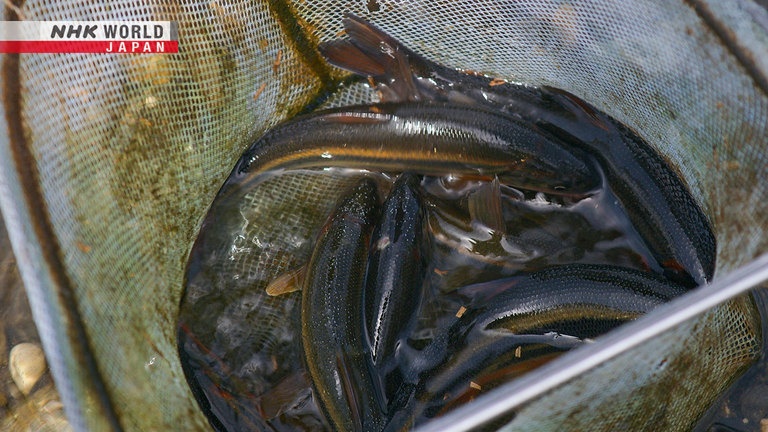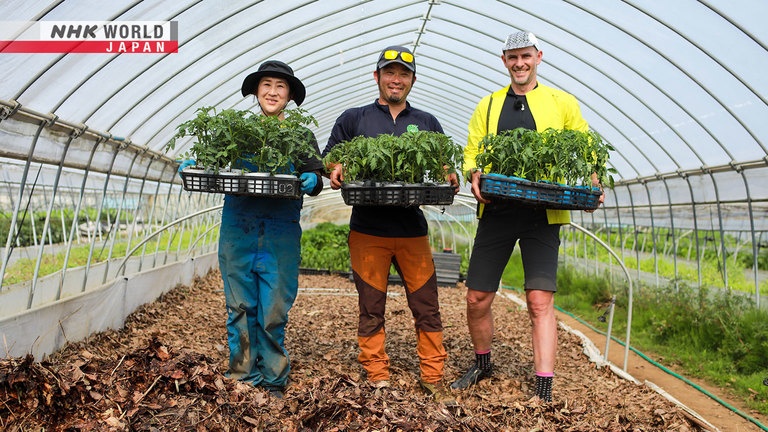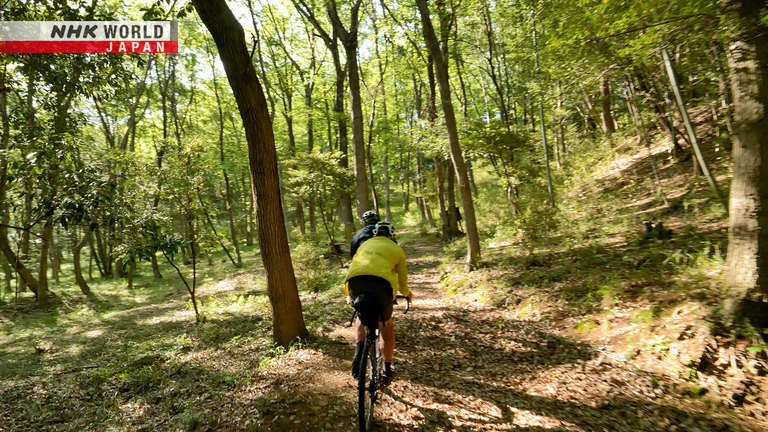Tochigi - The Cycle of Life
Tochigi is a lush green inland prefecture on the Kanto Plain, north of Tokyo. We're there at the height of spring, fields glistening with snow melt from the mountains as nature returns to life. We'll ride through the Nasu Highlands under streaming carp banners, catch spawning river fish fat with eggs and carry a huge hand-crafted dragon in a country town's festival. Our final encounter is with a young couple committed to farming in tune with the natural cycle, even making their own soil from gathered leaves.




Transcript
The best way to discover little-known sights and make even familiar places feel brand new,
is to go exploring by bicycle.
This time, our road takes us through Tochigi.
This landlocked prefecture is known for its beautiful forests and mountains.
We're here at the height of spring, the fields wet with water flowing from the mountains,
as nature revives after the passing of winter.
This is a fish called ugui.
Careful of the hole in the net.
It's the spawning season now,
and they change color.
Jagamaita! Jagamaita!
People in Tochigi are especially in tune with nature and the changing seasons.
There are farmers here still making rich soil the old way,
with fallen leaves from the forest.
This will turn it into soil.
It's a completely natural process.
Off we go, a following wind speeding us along through Tochigi in springtime.
The Kanto Plain covers a wide area of eastern Japan, that includes Tokyo.
Tochigi sits at the northernmost edge of this plain.
Our cyclist this time is Zac Reynolds, from Australia.
When Zac's not hill climbing, his favorite sport, he works for a cycle manufacturer.
OK, let's go!
I love this season, after the cherry blossoms have disappeared.
We're surrounded by these fields of livestock feed.
Just over there you can see the azaleas in bloom at the bottom.
Some yellowy greens, some darker light greens...
The darker cedar, evergreens there...
This is the color of spring to me.
Wow, look at this view!
Wow, looking down over this valley!
Look at all of those greens there!
This spring landscape is a mosaic, a symphony in green.
Wow, check this out.
Look at these carp streamers here, there must be hundreds of them.
"Koinobori."
"Koinobori" streamers are traditionally hung as a prayer for children to grow strong and healthy.
Now, when the wind blows it looks like the carp are swimming upstream.
We've come out along quite a big river here.
See, lots of this nice green foliage.
Some of these yellow flowers, I think they're canola flowers gone wild.
The Naka River flows from the Nasu mountains, fed by melting snow.
There's a couple of guys on a boat down the river here.
Oh, he's just casting a net.
I wonder what they can catch in here.
Hello!
- What are you doing?
- Fishing for dace.
We call it ugui.
Spring is the season to fish for it.
You've caught a lot.
In the spring spawning season,
these fish change color.
They turn orange.
The river also changes color in spring, taking on a cloudy whitish shade.
The river water turns this color in spring.
For me, it signals the arrival of the season.
It's caused by runoff from nearby rice paddies.
Preparing the fields for rice planting produces
a lot of muddy water.
This rises to the surface where it's warmed by the sun.
When the warm, muddy water runs into the river,
this tells the fish it's time to spawn.
Kuniyasu learned the unique ecology of this river as a child,
fishing with his father and grandfather.
Spring is also spawning season for Japanese striped loach.
- Ah!
- I see lots.
- Yes, plenty in this one.
- A good catch.
These are all "shimadojo."
This one's full of eggs.
It's almost ready to spawn.
A sign spring is in full swing.
This is the busy time for people too.
We all farm as well as fish.
I'm a rice farmer myself.
As a youth Kuniyasu left for the city, where he worked as a chef.
But in his mid 30s he couldn't forget this river, and decided to return to his roots.
The river was part of our daily lives.
I spent my whole childhood here.
I remember the feeling of wind in the spring,
and the smell of the river.
My grandfather would bring me down here
and carry me across the river on his back.
He showed me how to fish for ugui.
It's a great river for fish.
A day at the river, discovering the changes that springtime brings.
It's the next day, and Zac is riding from Tochigi city to the nearby town of Oyama.
It's a nice spot with these willows along the river too.
The old merchant houses lining these banks are a reminder of busier times.
This river was once packed with boats carrying rice and silk to the capital,
then called Edo.
Oh, looks like there's something going on here.
Hello!
Looks like they're making some sort of decoration.
- Good morning.
- Hello!
- What are you doing here?
- Today is May fifth, the day of the Jagamaita Festival.
- What is it?
- A dragon.
The "Ja" of "Jagamaita" means snake,
but it's actually a dragon festival.
It goes back about 400 years.
The Jagamaita Festival is unique to the Mamada district of Oyama.
The dragons are all handmade by local residents, to pray for rain and ward off disease.
It's the first time the festival has been held in three years, due to the Covid pandemic.
Give the dragon plenty to drink.
A purifying swig of sake to start the procession.
You drink too!
Lift it up!
Jagamaita! Jagamaita!
The original meaning of "Jagamaita" is thought to be:
"The dragon has come!"
So, the dragon's on the move.
We're heading up to the local shrine here for more of the ceremony.
Keep the head down!
Careful of the steps here!
Watch the head!
The dragons from the town's seven neighborhoods are now all lined up in the grounds of the shrine.
The next step is to take the dragons to drink in a sacred pond.
Jagamaita!
One more time!
Jagamaita!
The third district's dragon has drunk enough.
It's now leaving the pond tail first!
Why do they dunk it in the pond?
We make it drink water, although the original
legend is a bit different.
It's said the pond used to be filled with sake.
So drunken dragons rampaged through the town.
That's what we're imitating
as we carry it along the streets.
Energized by the pond water, the dragons parade through the town,
driving away any misfortunes.
Go up by the head, Zac!
Over the course of the day, the dragons will visit each house in the district.
People believe a visit by the dragon keeps their home safe from disease and disaster for the coming year.
Thank you very much!
This is is pretty heavy.
You can see why there's like 50-60 people carrying it.
A little bit of shift of the weight, it really comes down on you.
We have to move as one.
We're united by our purpose, too.
Everyone takes part in this annual ritual
to purify our neighborhood.
It only works when we all pull together.
The spirit of spring is still strong in this local festival.
Starting our last day on this beautiful wetland here.
Zac is now riding through Watarase-Yūsuichi, one of Japan's largest wetlands,
where beds of reeds stretch to the horizon.
There are some smaller farming villages.
It looks like some greenhouse cultivation here.
So yeah, we found this shop that grows seedlings for vegetables.
Hello!
What's in these green houses here?
Let's have a quick look in here.
They're growing summer vegetable seedlings, including tomatoes, eggplants and bell peppers.
These are getting nice and tall.
The soil looks nice and moist, and the leaves are really healthy.
They've got a bed of leaves underneath.
It's bedding like this.
I wonder why that is...
Hello!
Good morning!
What's the purpose of this bed of leaves
under the seedlings?
- To make soil to put in the pots.
- The leaves turn into soil?
- Look closely and you'll see bits of leaves.
- Right, there are small leaf fragments.
Soil made from leaves is called humus.
It's rich in nutrients and drains well, making it ideal for growing vegetables.
The nursery is run by Ōtsuka Yoshinobu and his wife, Fumie.
Yoshinobu took over the business from his father 22 years ago.
Let's see how they make their soil.
- These are the same leaves you saw before.
- This is where you store them?
Yes. We gather them from the surrounding hills.
This is rice bran.
We start by spreading it on the leaves.
My wife and I do this together.
She sprays water, while I mix in the bran.
One person can't do this.
After they've been stirred up, it's my job
to tramp them down like this.
This hardens the leaves into a solid mass.
It's an old traditional method.
- That looks like the hardest part.
- It is, because I mustn't stop.
- You need a strong back and legs.
- Oh yes, I'm pretty strong.
Trampling on the leaves triggers fermentation,
which turns them into soil.
- Soil is created by fermentation?
- Right. That's basically what happens.
Ōtsuka is taking Zac to show him where they collect the leaves.
Ōtsuka has been a keen cyclist all his life, and he sets a brisk pace.
That's it, up ahead.
Where they're going is an area known as a "satoyama:"
a semi-wild hillside carefully managed, for the benefit of the whole community.
It's hard going here.
- Are you OK? Got enough gears?
- If I run out of gears, I'll get off.
- Still plenty of fallen leaves.
- I see lots, yes.
This is where we always collect them.
You get all your leaves to make soil here?
Yes. In summer we cut the undergrowth
and in winter we gather the leaves.
In spring, deciduous trees, like "konara" oak, make this "satoyama" a lush green paradise.
We burn dead branches in our stoves.
It's all part of the natural cycle.
- All part of managing the "satoyama?"
- Right.
Check the view from here.
Amazing isn't it?
Looking down over his village reinforces Ōtsuka's determination
to preserve its "satoyama" for future generations.
You were surprised to see
how fallen leaves turn into soil.
But of course that's what happens
naturally in the forest.
I'm so used to this work, it was great to see
it fresh through Zac's eyes.
It gave me a whole new perspective.
I realized again how central the cycle of
nature should be to our lives.
I'm not very good at explaining such things.
But by selling seedlings I can spread the word
about the importance of our mountains.
Zac is now approaching the final goal of his journey,
a plateau 1,300 meters above sea level.
As we're getting higher you can see the leaves getting lighter again.
It's like we're going backwards into spring.
These mountain azaleas too, sort of reds and the pinks.
It's like we're going back in time into early spring again.
Looks like we're coming out into some grazing land.
Looks like a good spot.
Oh, what a view!
Oh, beautiful!
I guess we came up from over that direction.
The mountains of Tochigi fill the landscape, verdant with the fresh green of spring.
It was really easy to see that it's all part of a cycle.
I think with urban living it's easy to lose sight of the fact that we are living in this cycle,
and that you can't just sort of grow our food anywhere anytime.
But you need to sort of understand the environment that you're taking sustenance from,
and maintain that environment and its cycles, so we can keep doing that year after year.
And then meeting the people who are like living together with their land,
and sort of looking at that every day, and seeing the changes,
it sort of makes me appreciate where I live a little bit more deeply.
Spring in the mountains and villages of Tochigi,
the season of revival when the cycle of life begins once again.